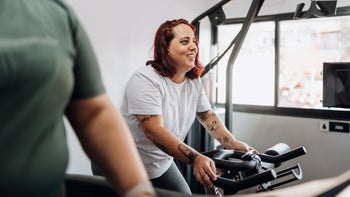
The 5 Most Effective Neck Stretches and Exercises for Pain Relief
Key takeaways:
Poor posture, injuries, and arthritis often cause neck pain and stiffness.
Neck stretches help boost mobility, correct muscle imbalances, and loosen tight muscles.
Strengthening exercises can support the neck and promote good posture.
Table of contents

Neck pain — whether it’s waking up with a stiff neck or having discomfort at the end of the day — is pretty common.
The average adult head weighs 10 lbs to 12 lbs in an upright position. But when you look down at your phone, the load on your neck raises by up to 60 lbs. (This strain is sometimes referred to as "text neck.") So it's no wonder many people have neck pain and stiffness.
Luckily, stretching and strengthening exercises can help.
Search and compare options
5 exercises to relieve neck pain
If you have neck pain, let your healthcare professional know before you try any new exercises. They can help you understand which moves are safe for you and which you should avoid.
And remember, although neck stretches and strengthening exercises can help ease pain and stiffness, they may also cause mild discomfort. They shouldn’t cause pain, however, so don’t do any moves that make your neck pain or stiffness worse.
Below, we review five neck stretches and strengthening exercises to discuss with your healthcare professional. Unless otherwise stated, you can begin each one in a seated or standing position. Make sure to maintain good posture — with your shoulders back, your head in a neutral position, and your core engaged — to stabilize your spine.
1. Side-to-side bends (lateral neck flexion)

Tight neck muscles that limit normal range of motion are often the cause of neck pain. This gentle stretching exercise, which involves bending your neck to the right and left, helps improve mobility.
Step 1: Slowly bend your head to the right, bringing your right ear toward your right shoulder.
Step 2: Hold for 5-10 seconds, feeling the stretch along the left side of your neck. Then, return your neck to a neutral position.
Step 3: Repeat the stretch with your left side, bringing your left ear toward your left shoulder and holding for 5-10 seconds. Then, return to a neutral position.
Step 4: Repeat 10 times on each side.
2. Forward neck bends (neck flexion and extension)

Forward and backward bends can improve mobility in your neck, making it easier to move your head up and down.
Step 1: Lower your chin toward your chest (flexion).
Step 2: Hold for 5-10 seconds, feeling the stretch in the back of your neck. Then, return your neck to a neutral position.
Step 3: Slowly bend your head backward, bringing your chin toward the ceiling (extension).
Step 4: Hold for 5-10 seconds, feeling the stretch in the front of your neck. Then, return to a neutral position.
Step 5: Complete the move 10 times in each direction.
Read more like this
Explore these related articles, suggested for readers like you.
3. Side-to-side turns (neck rotation)

This gentle stretching exercise is a great way to relax tight neck muscles, which can stop them from restricting your movement.
Step 1: Turn your head to the right and look over your shoulder.
Step 2: Hold for 5-10 seconds, feeling the stretch along the left side of your neck. Then, return your neck to a neutral position.
Step 3: Repeat the stretch on your left side, feeling the stretch along the right side of your neck. Then, return to a neutral position.
Step 4: Complete the move 10 times on each side.
4. Chin tucks (neck retraction)

Most people spend much of their time in a forward head posture. This can tighten and weaken neck muscles that help support your spine. Chin tucks help combat this by realigning your spine and stabilizing your neck.
Step 1: Maintain an upright posture as you move your head and chin straight back. Imagine moving your head backward along a horizontal plane and aligning your neck over your spine. But don't let your head and neck bend forward or backward.
Step 2: Hold this position for 5-10 seconds, then relax.
Step 3: Complete the move 20 times.
5. Levator scapulae stretch

The levator scapulae muscle connects your shoulder blades to your neck. Stretching it improves flexibility, which can help ease tension in your neck.
Step 1: Place your right hand behind your head.
Step 2: Turn your head to the right at a 45-degree angle.
Step 3: Gently pull your head down toward your right armpit, feeling a stretch along the left side of your neck. Hold for 30 seconds, then relax.
Step 4: Repeat the steps on the left side, then relax.
Step 5: Complete the move 3-5 times on each side.
What causes neck pain?
First, let's look at the anatomy of the neck. Your neck, or cervical spine, contains seven bony vertebrae that make up the spinal column. Flexible cartilage discs sit between each vertebra and act as shock absorbers. Your spinal cord sits inside the spinal column and contains multiple nerves. And there are various muscles and ligaments that support your head and neck.
Typically, neck pain results from injury to one or more of these structures. Acute neck pain is usually not serious and will go away in a couple of weeks. But some conditions can last longer if left untreated.
Common causes of neck pain include:
Muscle strain: Soft tissue injuries that affect the muscles or ligaments are among the most common causes of neck pain and stiffness. Awkward sleep positions, prolonged poor posture, and overuse often cause these types of injuries.
Injury: Injuries from car accidents, contact sports, or falls may cause neck pain. The damage can affect your soft tissues, resulting in injuries like whiplash. Or it can cause more serious fractures and dislocations.
Age-related wear and tear: As you age, normal wear and tear can lead to osteoarthritis, which may cause neck problems. For example, discs may wear down and lose flexibility (cervical disc degeneration). Or the space around the spinal column may start to narrow, causing spinal stenosis or a pinched nerve.
Herniated disc: A herniated disc occurs when a cervical disc protrudes. This puts pressure on your nerves or spinal cord, resulting in pain, tingling, and weakness.
Osteoporosis: With osteoporosis, weak or brittle bones raises the risk of fractures. The condition can also cause neck issues, including pinched nerves, pain, stiffness, and numbness.
You should see a healthcare professional about neck pain if:
Your neck pain appeared after a car accident or other injury.
Your symptoms haven’t improved after 1-2 weeks.
You experience pain, tingling, or numbness in your arm.
You notice a loss of coordination.
You have a headache or fever.
You have any vision changes or light hurts your eyes.
You faint or lose consciousness.
What other remedies can relieve neck pain?
In many cases, modifying what activities you do, doing neck stretches and exercises, and applying targeted ice or heat therapy, are effective ways to relieve neck pain. But if those strategies don’t provide enough relief, consider getting checked out. A healthcare professional can make sure nothing more serious is going on and make recommendations for other ways to manage your symptoms. These recommendations may include:
Physical therapy
Massage therapy
Core strengthening exercises
Changes to your workspace or new work restrictions
Strategies for better posture
Most experts don’t recommend neck braces or prolonged rest, which can worsen neck stiffness.
The bottom line
There's a reason people say there's nothing worse than a pain in the neck. Although it’s usually not serious, neck pain and stiffness can be uncomfortable and inconvenient. Muscle strain from poor posture or overuse, injuries, and age-related wear and tear are usually to blame.
But conservative treatments, including stretching and strengthening exercises, can help. Just be sure to check with your healthcare provider before trying new moves to ease your symptoms.
Why trust our experts?



References
Childress, M. A., et al. (2020). Neck pain: Initial evaluation and management. American Family Physician.
Gandhi, S. V., et al. (n.d.). Cervical spine. American Association of Neurological Surgeons.
Gross, A. R., et al. (2009). Knowledge to action: A challenge for neck pain treatment. Journal of Orthopaedic & Sports Physical Therapy.
Healthdirect. (2022). Neck pain.
Kim, J. H., et al. (2016). The effect of applying a head-weight device on cervical angle and pain of neck muscles. Physical Therapy Rehabilitation Science.
Lee, D. Y., et al. (2017). Changes in rounded shoulder posture and forward head posture according to exercise methods. Journal of Physical Therapy Science.
Massachusetts General Hospital. (n.d.). Cervical spinal stenosis.
Park, D. K. (2021). Neck pain. OrthoInfo.
Sheikhhoseini, R., et al. (2018). Effectiveness of therapeutic exercise on forward head posture: A systematic review and meta-analysis. Journal of Manipulative Physiological Therapeutics.





























